by Lisa Cooke | Apr 18, 2019 | 01 What's New, Family Reunions, Memory Lane
Family reunions are the perfect place to share your family history with others. The trick is to keep things light and fun!
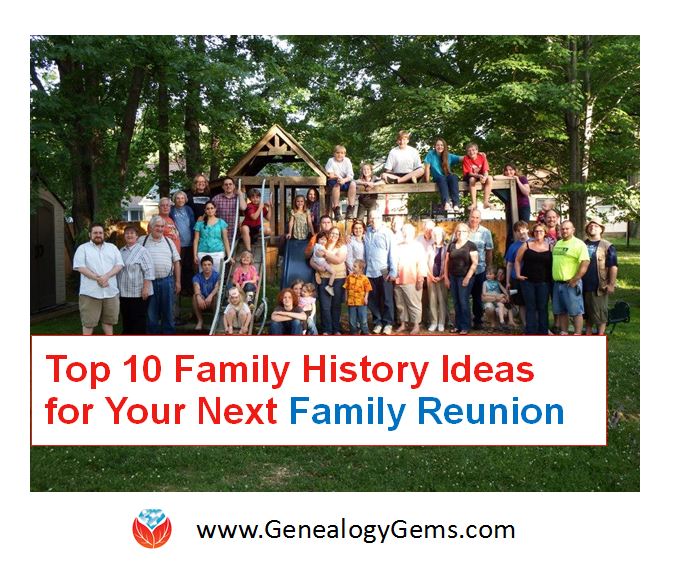
These top 10 family reunion ideas can sprinkle a healthy–and tasty– dose of heritage into your next family gathering.
10 Family Reunion Ideas for Incorporating Family History
1. Family Tree Hopscotch.
This life-sized bean bag toss/hopscotch game quizzes family members on the names of ancestors. It’s aimed at kids, but adults enjoy it, too!
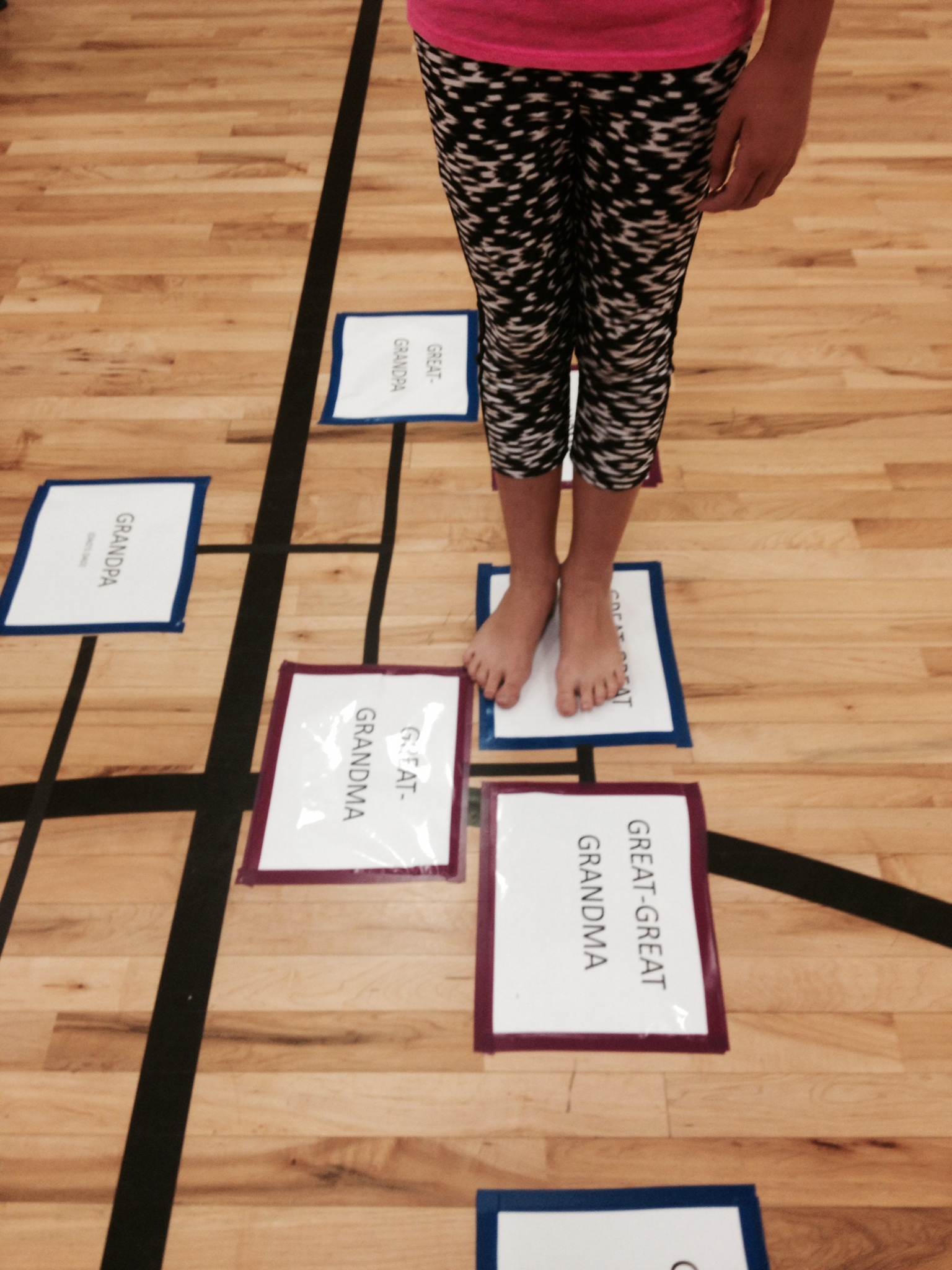
2. Table Talk:
If you’ll be seated at tables, provide an icebreaker that can double as a family history gathering opportunity.
Place a form at each place setting for guests to fill out. (Or a short list of questions for people to answer, if a videographer will make the rounds at each table)
Include questions like:
- What’s your earliest childhood memory?
- Who’s the earliest ancestor you have a photograph of?
- What are three things you remember about great-grandmother?
Can you imagine how this Martha Stewart placecard on Pinterest (which I found by searching “family reunion history” at Pinterest, a great place for collecting family reunion ideas) might be adapted this way?
3. Put Ancestors at the Center of Things:
Centerpieces or displays that celebrate your heritage will attract curious relatives and may prompt memories and comments.
One of our Premium members sent us a description of her conversation-starting centerpiece: click here to read about it.
If guests won’t be seated at tables, set up a family history display table next to the refreshments table (where they’re most likely to walk by!). Let them know that this is their gift to you. You could even have some sort of treat or little sticker they can wear that says, “I shared our family history: Have you?”
4. Sweet Memories:
Create “Sweet Memories Candy Bars” that feature family history. I write about these in my book Genealogy Gems: Ultimate Research Strategies. They are great conversation starters–and the candy is a definite incentive to get people talking.
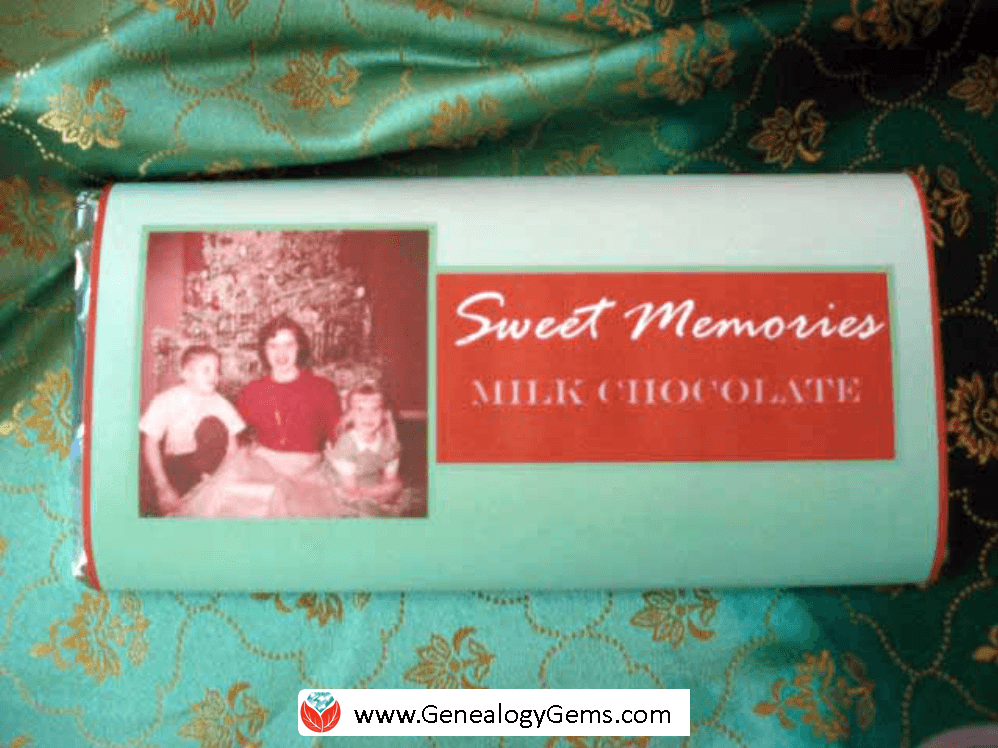
My family adored this customized candy bar
5. Heritage Scrapbook:
A mini, accordion-style scrapbook craft project makes a fun, meaningful activity for all ages. Relatives can work on these alone or in little groups. It’s the kind of project that would be easy to adapt for any family’s background.
6. Have Yourself a Merry Little Family History:
Make a holiday craft that celebrates your heritage. Click here for a free PDF with directions on making a heritage Christmas stocking. Or make a family history-themed wreath, following these instructions I posted on YouTube.
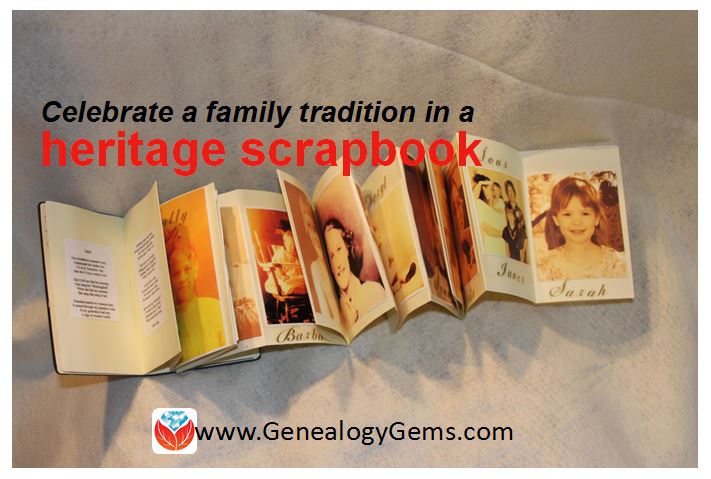
7. Games:
Try a heritage twist on the classic wedding or baby shower games. Create a crossword puzzle or word search with family surnames, hometowns, favorites and more. Here’s a link to one website that creates a puzzle for you for free.
Or invite guests to bring their own baby pictures. Post them for all to see and let your guests guess who each baby is.
8. Cook up some Conversation:
When I was looking for family reunion ideas a while back it occurred to me that my family’s love of food was a great angle to tap into.
Heritage cookbooks are a time-honored way to share family recipes, and they can double as a reunion fund-raiser if you like.
Ask family members to submit recipes. Add recipes from ancestors. Share them with each family or guest who attends.
Remember, it’s not hard to create an e-book of recipes that you can’t share by email or on Facebook. An easy version of this idea: Snapfish offers a really cute way to share individual recipes on pre-printed cards. Only one or two recipes required to make this a success!
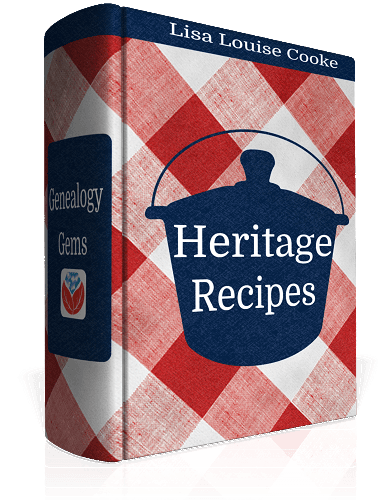
9. The Amazing Family History Scavenger Hunt:
Create a list of questions that will require some scavenger-hunt type searching among your relatives.
Questions might include finding someone who has at least 10 grandchildren, was born in California, is about to start kindergarten, likes the Beatles, etc.
Research ahead of time so that questions all apply. This activity gets people talking!
10. DNA Day:
Purchase a few DNA kits for genealogy. Have them on hand in case family members want or are willing to have their DNA swabs done. This is especially great if older relatives are coming, but might not complete the swabs if you mailed them to them.
BONUS FAMILY REUNION TIP:
Did you know you can organize a great family reunion on Facebook–even if not everyone is ON Facebook? Click here to read a post with great tips about using Facebook to keep everyone in the loop and share the good times with those who can’t attend.
Be sure to share this article on family reunion ideas with the family reunion planners you know! It can be so helpful to get a fresh burst of ideas when planning big family gatherings.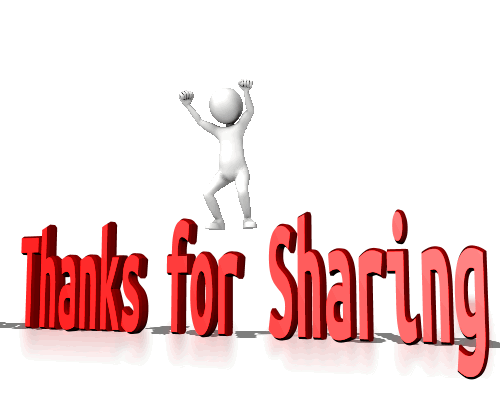
by Lisa Cooke | Jun 21, 2017 | 01 What's New, Family Reunions, Health History, MyHeritage
There’s an easy, free way to analyze your family tree for patterns! Discover your ancestors’ average life expectancy, most common first names, how long they stayed married, and more. Share the results at your next family reunion, or use them to understand your family health history just a little bit better. Here’s how.
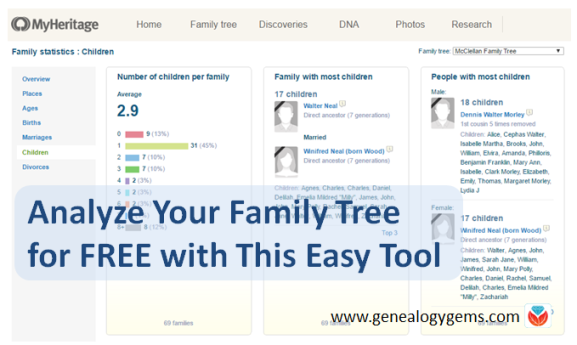
Whether you’re a paying subscriber to MyHeritage or are signed up as a free user, you have access to a little-known but fascinating tool on the site: Family Statistics.
You’ll find this tool under the Home tab:
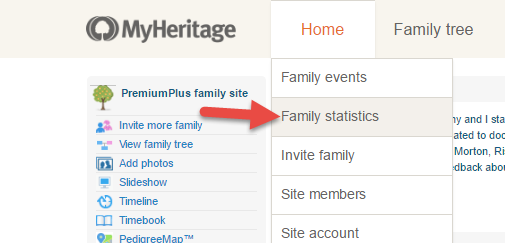
Use this tool to explore various statistics and patterns in your family history, and to spot the “record-holders” on your tree. You don’t have to enter any information. Just click the topic on the left that you want to view (overview, places, ages, births, marriages, children, divorce). Easy-to-read infographics and summary charts will appear:
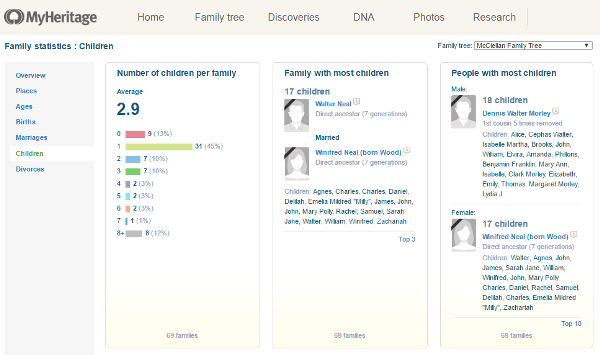
The Family Statistics tool will tell you:
- the most common places of birth, death, and residence
- most common surnames and male/female first names
- average life expectancy for men and women
- longest-lived and shortest-lived ancestors
- oldest/youngest living relatives on tree
- most common birth month, and how many people were born in each month
- number of marriages, and the longest and shortest marriages
- age at first marriage and who was the youngest/oldest when they married
- the biggest age differences in a couple
- total number of divorces, as well as the average age (and oldest/youngest) age at divorce, and the longest marriage ending in divorce
- average number of children per family and people with the most children
- the youngest/oldest age when having a child
- the average and biggest/smallest age difference between oldest and youngest children
You can run these statistics for all your trees together or individually. Here are some of the different ways to use the data:
For your research: Watch for possible errors or omissions on your family tree. Do you really have a relative who lived to be 112 years old, or did someone neglect to enter a death date?
For fun: Watch for interesting things to share in a trivia game or quiz at your next family reunion. You might even consider creating a “Hall of Fame” for that great-grandfather who lived to be 103, or that great-aunt who had 14 children. (Remember, don’t embarrass anyone by sharing sensitive or confidential information about living relatives or the recently-deceased.)
For understanding: Do certain patterns tend to run in your family, such as having children at a younger or older age?
For family health history: Longevity–age at death–is a measure in Family Statistics that relates to your family health history. You can’t look at cause of death with this tool, but click here to read about a clever way to look at causes of death in your family.
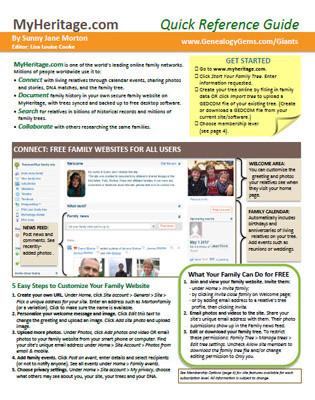 MyHeritage is known for the technology tools on its site, such as its new Collection Catalog, the Discoveries pages, its DNA matching (click here to upload your raw data for FREE!), automatic record matching in unindexed content such as books, and automatic name translation in the search function.
MyHeritage is known for the technology tools on its site, such as its new Collection Catalog, the Discoveries pages, its DNA matching (click here to upload your raw data for FREE!), automatic record matching in unindexed content such as books, and automatic name translation in the search function.
Get up to speed on what MyHeritage has to offer in our totally-affordable MyHeritage Quick Guide, newly updated for 2017! Also check out our brand new quick guide, Genealogy Giants: Comparing the 4 Major Websites Quick Guide, which compares MyHeritage to what you’ll find on Ancestry, FamilySearch and Findmypast. Each has fantastic features you’ll want to know about!

by Lisa Cooke | Oct 24, 2016 | 01 What's New, Inspiration, Kids
If you’re like me, you would give anything to share family history with kids and not be met with an eye roll. Here are three clever ways to capture their imagination, put a smile on their face, and most importantly, help them soak in the importance of their family history. You’re going to want to try them today!
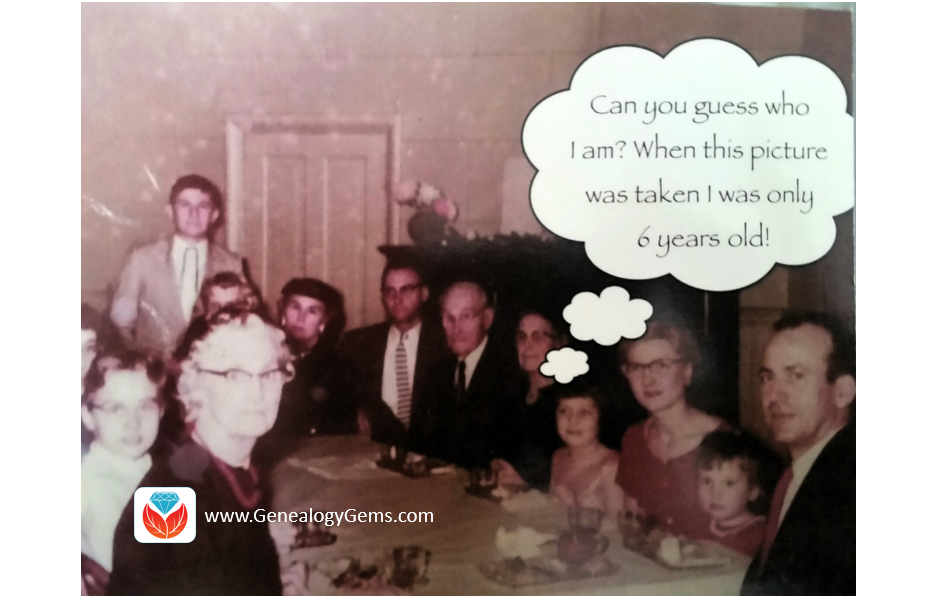
Share Family History with Kids through Surprising Greeting Cards
About a year ago, my mother-in-law began sending monthly cards to each of the families. Though addressed to the grandchildren, they were fun for everyone. My youngest, now 9 years old, excitedly tears into the envelope and wants to be the first to see the card. She smiles and giggles at Grandma’s funny stories. We keep the card on the front of the fridge until the next one comes. They have become special keepsakes we will save for future generations.
These glossy greeting cards hold special pictures and stories of her past. One such card had an old picture of her as a child sitting around the table with her extended family.
The front of the card said, “Can you guess who I am? When this picture was taken I was only 6 years old.” The inside of the card then told the names and relationships of those around the table.

Another card she created was a collage of Christmas ornaments. It inspired me to create a card that shared images of my own family Christmas heirlooms and ornaments of the past. What a neat way to preserve that part of our history and share it with the next generation. After all, stories of how our ancestors celebrated special events is often enjoyed by even those that don’t consider themselves ‘genealogists.’
Share Family History with Kids through Shareable Art for Social Media
Getting a card in the mail was fun for the younger ones who rarely get a letter, but our teens were more interested in what was showing up on their social media feeds. Teen family members spend many hours on social media. Facebook, Twitter, Instagram, and Pinterest are just a few of the many outlets available today. If the kids are already surfing your feed, why not share with them some family history in a creative, colorful post.
Recently, I downloaded an app called Rhonna Collage. Rhonna Collage is available only for Apple devices, but there is a similar app for Android devices called Rhonna Designs.
As I found new pictures of my ancestors, I used the Rhonna Collage app to design shareable art for posting to social media. I added a background, a picture, and text. Then, I shared my creation to Facebook, Instagram, and Twitter. My cousins swooned and the teen nieces and nephews clicked the “thumbs-up” or “heart” emojis to show their like for the post. Sometimes, they even post a comment or question! Even better, my designs can be downloaded by them, shared again, or even printed.
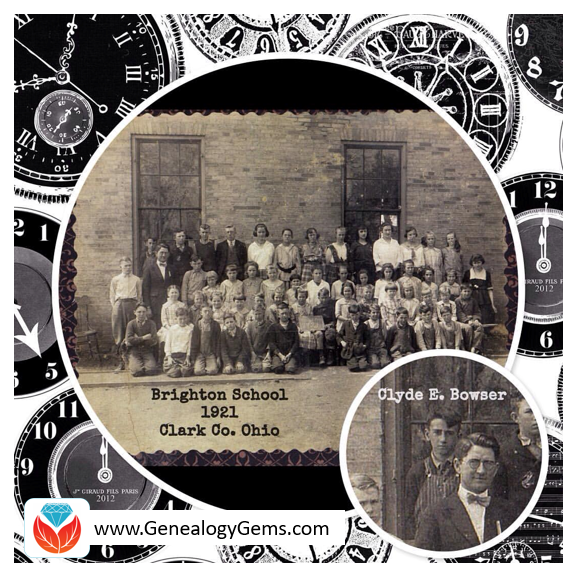
Share Family History with Kids at an Ancestor Birthday Bash
If you are interested in sharing family history in a more dramatic way, ancestor birthday bashes may be right up your alley!
Ancestor birthday bashes started when my sister and I wanted an interactive activity that immersed the kids in their family history. Everyone loves a birthday party, right? So, we created ancestor birthday bash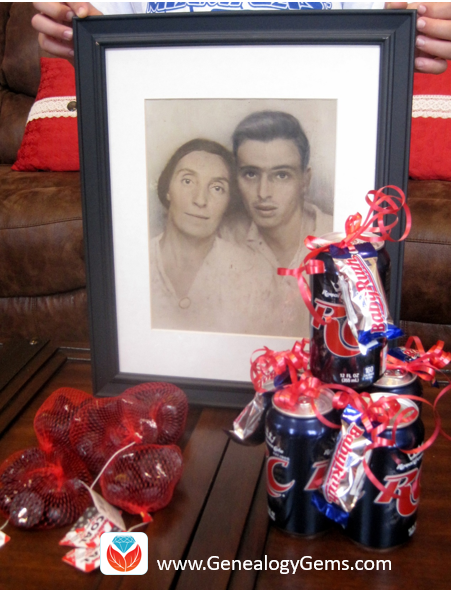 es.
es.
The party takes place on or near the birthday of an ancestor. Our first birthday bash was for my grandpa, Robert Cole. I interviewed my mother, his daughter, about all his favorite things. We used his favorite treats of RC Cola and Baby Ruth candy bars as decoration and treats for the party. Grandpa Cole was also a coal miner and we were able to find bags of coal (made of chocolate!) to give to each of the kids. During the celebration, we shared fun stories and pictures of Grandpa.
A day or so later, my niece Candice told her mother, “I know why Grandpa Cole’s favorite pop was RC.” When asked why, she replied, “Because his initials were R. C.!” We considered that a win! She was paying attention and all had a great time.
Ancestor birthday bashes are a way to teach cultural history as well. If you celebrate an ancestor originally from another country, you could include authentic food, games, and decorations to make the event really memorable.
Even More Ways to Share Family History with Kids
These were just three ways to teach and share your family history with your kids, and even nurture the next generation of budding genealogists. For even more ideas, read the posts below.
How to Create a Coloring Book for Family History
Family Reunion Ideas: Top 10 Ways to Incorporate Family History
 If you have a great idea of your own and you’ve snapped some photos of you sharing family history with your kids, feel free to post them on our Facebook page. You inspire us!
If you have a great idea of your own and you’ve snapped some photos of you sharing family history with your kids, feel free to post them on our Facebook page. You inspire us!
by | Jun 1, 2016 | 01 What's New, DNA, Family Reunions

Wish your family would take more interest in its history and even have its DNA tested? Here are 3 tips for talking about DNA at your next family reunion or gathering.
In the northern hemisphere, it’s summer time–prime family reunion season! If any of your plans this summer involve visiting with extended family, check out these 3 tips for using DNA to get your family excited about family history.
1. Show your ethnicity results.
Start off with the most flashy and entertaining part of the DNA test, your ethnicity results. Most of the time they don’t actually help you DO family history, but they definitely get people interested.
When you pull out the results, you might also want to have handy your family’s migration chart. This was recently popularized by J. Paul Hawthorne and is a simple way to describe the birth locations of your ancestors so you can visualize the migration of your family over the course of several generations. If you want to try it, here is a link to a spreadsheet I made based on his.
Then you can pull out your DNA test results and talk about how much of your DNA test results are reflected in your ethnicity chart. You might even have a good chuckle over some of the more outlandish claims (22% Scandinavian?! Where did that come from?). Now is a good time to mention any family stories about Native American Princesses or African cousins.
2. Show your DNA match list.
Next, it’s time to segue to how DNA testing really helps your family history. Show them how your relatives show up on your DNA match list. You can then show them an individual on your match list that you have figured out your relationship to. You can weave in just a bit of the genealogical research you did to find your common ancestor, and end with the cool fact that you actually have DNA from that ancestor, and so does your match! If you are especially lucky, the person you are talking to will also have some connection to this ancestor, and you can tell them that if they take a DNA test, it can help them document their relationship to this ancestor as well.
3. Invite relatives to test.
If you find yourself at a family reunion for a particularly pesky set of ancestors for whom you don’t know much about their parents or grandparents, this is a perfect time to help your family members understand that they might be THE ONE, the one who holds the right combination of genetics to help you bust through that brick wall.
I myself will be attending the Chenoweth Family Reunion this year, though I am only an honorary Chenoweth. They have the ambitious goal of finding direct paternal line descendants of the 21 continuing lines of the 29 grandsons of John Chenoweth and Mary Calvert, and they are over half-way there! As part of their festivities they are including a special DNA lecture on the progress of their project.
Having a specific goal like this really helps focus your family on a particular effort, and lets them track the progress of both the DNA and the traditional research. It is also very unifying, especially for a group as large as theirs. They all wear different colored T-shirts to represent the different lines they descend from. But when we look at the DNA, it is clear that, at least in their YDNA, there is no distinction, they are certainly all part of the same paternal line.
 More DNA Gems from Diahan Southard
More DNA Gems from Diahan Southard
3 Reasons to Test Your DNA for Genealogy
When to Do an mtDNA Test for Genealogy
Results May Vary: One Family’s DNA Ethnicity Percentages

by Lisa Cooke | Apr 10, 2016 | 01 What's New, Craft & Displays, Family Reunions, Heirloom
A giant family tree quilt documents 9 generations and just over 2600 family names. Here’s how the quilter completed this beautiful family heirloom.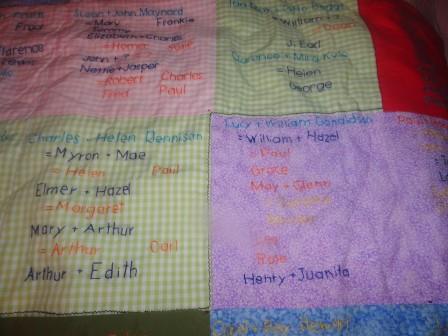
Not long ago, I came across this article from a local news outlet about the White family celebrating its 104th reunion. That’s quite an accomplishment, but what really caught my eye was the heirloom on display: a family tree quilt so large it couldn’t easily fit in a single photograph.
I tracked down the designer and creator of the family tree quilt. She’s a busy young mom named Jennifer Reiter. “Before we had our 100th reunion, I was reading a book with my girls about pioneer days,” she says. “A little girl was traveling. When they arrived at their destination, they made a quilt with all the memories from their favorite dress material. I got a crazy idea to do something like that for our family’s 100th-anniversary reunion: a quilt with everyone’s names on it.”
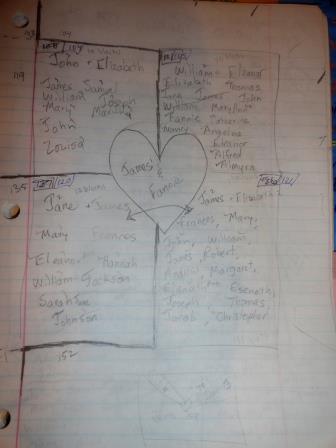 It wasn’t an easy undertaking. Jennifer took the names from a family history book her mother-in-law had. The founding couple from the 1700s had four children. Jennifer designed the quilt such that each quadrant of the quilt would represent one branch of the family. She sketched out her design across 46 pages from a notebook. Then she copied everyone’s names onto quilt block templates that were sent each out to volunteers in the family to help hand-stitch.
It wasn’t an easy undertaking. Jennifer took the names from a family history book her mother-in-law had. The founding couple from the 1700s had four children. Jennifer designed the quilt such that each quadrant of the quilt would represent one branch of the family. She sketched out her design across 46 pages from a notebook. Then she copied everyone’s names onto quilt block templates that were sent each out to volunteers in the family to help hand-stitch.
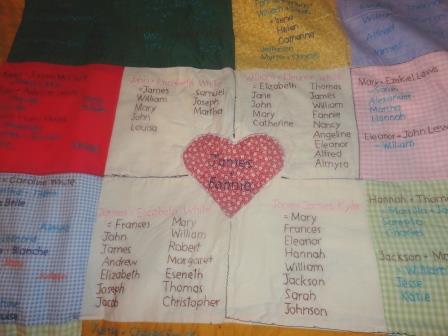 All the descendants’ names are on the quilt, Jennifer reports. “Each family unit appeared on one square. If a child got married and had a family, they got another square of their own. Each generation was a different color thread. My color is orange, so I can easily see who else is from the same generation I am. I tried to keep the colors of the fabric about the same, family-wise, too.”
All the descendants’ names are on the quilt, Jennifer reports. “Each family unit appeared on one square. If a child got married and had a family, they got another square of their own. Each generation was a different color thread. My color is orange, so I can easily see who else is from the same generation I am. I tried to keep the colors of the fabric about the same, family-wise, too.”
“It took a year,” Jennifer says. “I didn’t get quite as much help as I 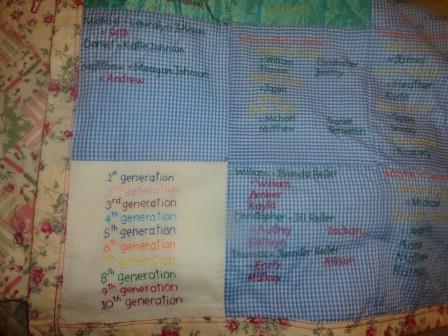 thought I would.” The final quilt documents 9 generations with 2601 names in it on a quilt that’s larger than king-sized. There are 256 quilt blocks, each of them 6″ square.
thought I would.” The final quilt documents 9 generations with 2601 names in it on a quilt that’s larger than king-sized. There are 256 quilt blocks, each of them 6″ square.
The quilt made its debut appearance at the 100th White family reunion, and a few years since then. It also took an honorable mention in the county fair. But she learned a lesson about letting it out of her sight too often: “There were a few years it was missing after it got left at the reunion. Someone went to the camp and they were looking for it again. The secretary had it. Now I have it my possession permanently.”
What an amazing accomplishment–and what an heirloom for the White family! Thanks for sharing it with us, Jennifer.
More Inspiring Family Quilts from Genealogy Gems
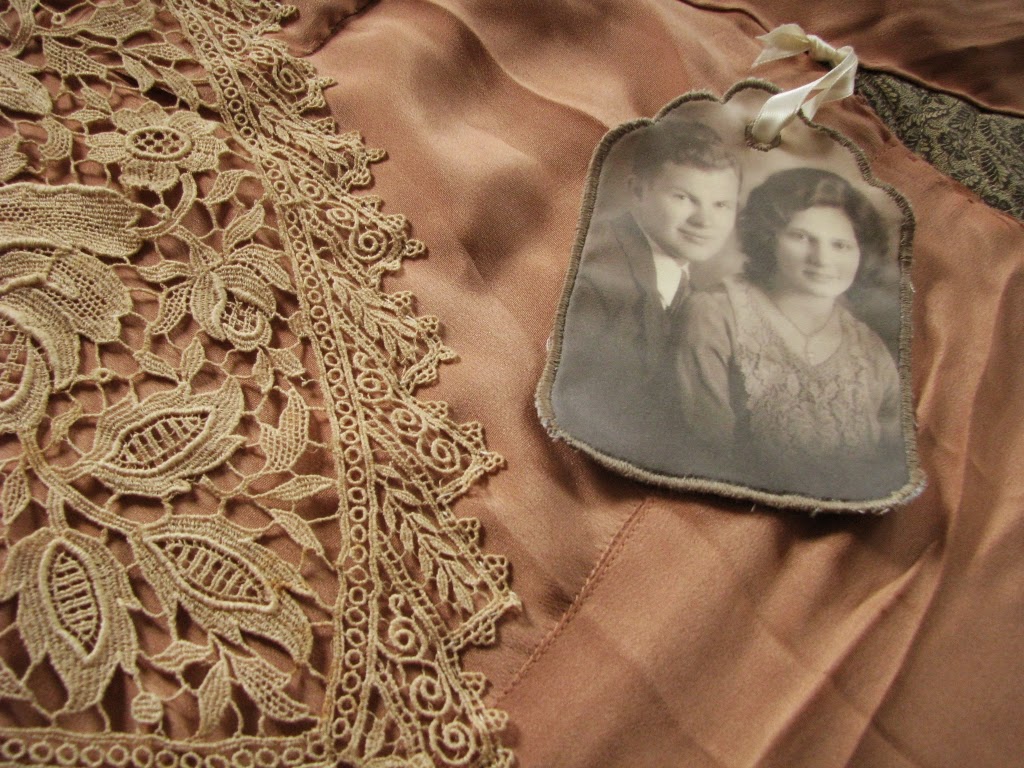 A New Heritage Quilt from Old Family Fabrics (with an entire wedding dress sewn into it!)
A New Heritage Quilt from Old Family Fabrics (with an entire wedding dress sewn into it!)
A Photo Quilt Stitches Together Childhood Memories
A Quilt that Brought My Family Together (story in free Genealogy Gems podcast)














 es.
es.



 It wasn’t an easy undertaking. Jennifer took the names from a family history book her mother-in-law had. The founding couple from the 1700s had four children. Jennifer designed the quilt such that each quadrant of the quilt would represent one branch of the family. She sketched out her design across 46 pages from a notebook. Then she copied everyone’s names onto quilt block templates that were sent each out to volunteers in the family to help hand-stitch.
It wasn’t an easy undertaking. Jennifer took the names from a family history book her mother-in-law had. The founding couple from the 1700s had four children. Jennifer designed the quilt such that each quadrant of the quilt would represent one branch of the family. She sketched out her design across 46 pages from a notebook. Then she copied everyone’s names onto quilt block templates that were sent each out to volunteers in the family to help hand-stitch. All the descendants’ names are on the quilt, Jennifer reports. “Each family unit appeared on one square. If a child got married and had a family, they got another square of their own. Each generation was a different color thread. My color is orange, so I can easily see who else is from the same generation I am. I tried to keep the colors of the fabric about the same, family-wise, too.”
All the descendants’ names are on the quilt, Jennifer reports. “Each family unit appeared on one square. If a child got married and had a family, they got another square of their own. Each generation was a different color thread. My color is orange, so I can easily see who else is from the same generation I am. I tried to keep the colors of the fabric about the same, family-wise, too.” thought I would.” The final quilt documents 9 generations with 2601 names in it on a quilt that’s larger than king-sized. There are 256 quilt blocks, each of them 6″ square.
thought I would.” The final quilt documents 9 generations with 2601 names in it on a quilt that’s larger than king-sized. There are 256 quilt blocks, each of them 6″ square. A New Heritage Quilt from Old Family Fabrics
A New Heritage Quilt from Old Family Fabrics


